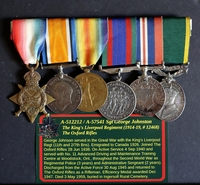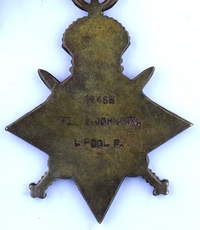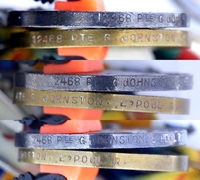
12468 / A-512212 / A-57541 Sergeant George Johnson
King's Liverpool Regiment
the Oxford Rifles
By: Capt (ret'd) Michael M. O'Leary, CD, The RCR
George Johnson was born in Liverpool, Lancashire, England, on 7 Sep 1895. (Throughout Johnson's records, and even on his officially issued medals, his surname is spelled both Johnson and Johnston. This narrative will use the former spelling.)
Two weeks after the outbreak of the First World War, Johnson enlisted with the King's Liverpool Regiment in the British Army on 18 Aug 1914. His regimental number was 12468. The regiment's medal roll shows that Johnson served with the 11th Battalion and then the 2/7th Battalion. He served throughout the First World War with the regiment and was discharged on 22 Mar 1919.
Having emigrated to Canada in 1926 and settled in Ingersoll, Ontario, Johnson enrolled in the Oxford Rifles, a unit of the Canadian Militia on 28 Jun 1938. the following year, he was ready to be called into service with his Canadian regiment when the Second World War began. Johnson's original regimental number with The Oxford Rifles was OR 1075. On first responding to the regiment's call for volunteers in August 1940, he would be assigned the number A-510012 from the Second World War number block given to the unit. This would in turn be replaced by a number from District Depot No. 1; A-57541, which he served under through the war. On his later return to the Oxford Rifles after the war he would be given a new number from their wartime block, A-512212.
The first two lines in Johnson's service record have been struck out. In the first, he is shown to have been taken on the strength of the Oxford Rifles on 15 Aug 1940. The second line shows that he was transferred from the Oxford Rifles to No. 11 Militia Training Centre at Woodstock on 4 Sep 1940. The Training Centre would remain numbered "11" through the war, but would change titles a few times under Active Service requirements.
The next entry in Johnson's service record perhaps established why the preceding lines were crossed out. On 4 Sep 1940, he is shown to have been called out on Active Service under General Order 139 of 1939 and attached to No. 11 Basic Training Centre at Woodstock. Moving to active status, Johnson was struck off the strength of the Oxford Rifles. The preceding entries were likely struck through in order to ensure they did not create confusion over which date was the commencement of his full time service.
General Order 139 of 1939 was published in the Canada Gazette:
"GENERAL ORDERS, 1939
"The following Order is promulgated and issued to the Canadian Militia by Order of the Minister of National Defence.
"Headquarters, Ottawa,
3rd September, 1939.
"G.O. 139
CALLING OUT THE MILITIA ON SERVICE
"Pursuant to the Regulation made by His Excellency, The Governor in Council, by Order in Council of the 26th August, 1939, P.C. 2386, the Minister of National Defence calls out on service, for purposes pertaining to the organization of the Canadian Active Service Force, such Officers and Other Ranks in the respective Military District as may be selected or detailed therefor by the Adjutant-General, effective 26th August, 1939.
"H.Q., 54-27-3-7 M.N.D, By Command: H.W. MATTHEWS, Major-General, Adjutant-General."
On a form describing the particulars of Johnson's family prepared at the time of his enlistment, the names and ages of Johnson's children were recorded. George and Ada had four children; Grace (16), George (15), Thomas (14), and Ada (8).
Effective 30 Apr 1941, Johnson ceased to be employed under General Order 139 of 1939. On ceasing to be a called-out soldier of the Militia, he was officially taken on the strength of No. 1 District Depot (Active Force). While the headquarters of the District Depot was in London, Ont., Johnson remained in Woodstock and was attached from the Depot to No. 11 Advanced Driving and Maintenance Training Centre.
A webpage published by Archeion, the Archives Association of Canada, provides a detailed description of the Training Centre's activities during the Second World War:
"Construction on the Militia Training Camp at the Woodstock Fairgrounds began September 1940 with A.J. McKinney in charge of carpentry and J.A. Vance as Contractor and Superintendent of Construction. Known as No. 11 Training Centre, it was officially opened in October 1940, with Lt.-Col. R.B. Crouch named as Commanding Officer.
"The school included barracks, for trainees as well as officers, a kitchen and mess hall, lecture rooms and library, office space, quartermaster store, rifle range, parade ground, mechanic shops, etc. The fairground and bandstand were converted to the parade ground for inspections, as well as social events for the men and the public. Such events included an all-star professional and amateur boxing show in June 1942 and the Lowney's Caravan show presented by Lowney's Young Canada Club in August of the same year.
"Men were trained on driving and repairing military vehicles such as universal carriers, field artillery tractors (F.A.T.'s), motorcycles, trucks, etc. The School also had several training areas located outside the city with conditions that were meant to reflect the landscape they would face in Europe including water, mud, gravel, hills, and forested area. Training Area No. 1 was located north of Eastwood; Training Area No. 2 included the A.F. Hamilton Gravel Pit; and Training Area No. 3 included the Hewitt Farm, 13th Line, William Dunn Gravel Pit and the McKay Bros. Farm (near Tollgate Side Road). Training Areas 2 & 3 were later expropriated by the Upper Thames River Conservation Authority and turned into the Pittock Conservation Area. The school also conducted two manoeuvre training exercises in the Bruce Peninsula in 1943 and 1944, as well as a simulated sea and airborne attack near Goderich in 1944.
"On May 12, 1941 the camp officially became known as S-11 Advanced Driving and Maintenance School and in January 1943 it was renamed S-5 Canadian Driving and Maintenance School until 1946 when the camp closed. On October 9th, 1943 the school officially opened its sports field with a football game between the Wester University Mustangs and the Hamilton Navy team. In August 1945 the school held it's Civic Day Event, open to the public, with a number of sporting events include sprints, high jump, C.W.A.C. tire changing competition, and a three-legged race. Over the years, the school also conducted several "open house" events held to benefit civilian recruiting as well as contributed to the Victory Loan Campaigns through parades and other fundraising opportunities. In November 1944 a mock execution of Hitler and Hirohito was held in front of the Woodstock City Hall as part of an event put on by the Canadian Driving and Maintenance School in support of the 7th Victory Loan Campaign.
"The school closed in March 1946 with remaining personnel being transferred to Camp Ipperwash. Around 23,000 men passed through the school for training during its existence."
George Johnson officially enrolled in the Canadian Army (Active Force) at No. 1 District Depot, London, Ont., on 1 May 1941. His attestation paper shows that he was married and living with his wife, Ada, at 164 Victoria St., Ingersoll, Ont. Johnson's stated trade was that of butcher. His religious denomination was Church of England. Johnson's attestation paper also noted his past service in the Oxford Rifles of the Canadian Militia and the King's Liverpool Regiment of the British Army. Johnson was given the service number A-57541 from a block of numbers assigned to the District Depot for general recruiting. This number replaced his service number in the Oxford Rifles, A-512212. In addition to his pay, which started at $1.70 per day and increased to $2.20 per day when he later held the rank of sergeant, Johnson was authorized to receive a dependent's allowance of $59 per month.
Johnson was granted a two-week leave furlough commencing 15 May 1951. he returned to the unit at Woodstock on 29 May. Later that year, he was promoted to the rank of Acting Lance Corporal (with pay) to complete establishment on 16 Sep 1941.
Johnson was struck off the strength of No. 1 District Depot on 1 Jan 1942 and transferred to the Home War Establishment (HWE) of S-11 Advanced Driving and Maintenance School as the training centre was then titled. On 13 Mar 1942 he was promoted to Acting Sergeant, without pay. Not quite two months later, on 1 May 1942, he was confirmed in the rank of Sergeant, with pay, to complete the unit establishment. On the same date of his rank was confirmed, Johnson was granted 14 days furlough with pay from 18 May to 1 Jun 1942.
Back at the training school, on 2 Oct 1942 Johnson was sent On Command (i.e., a temporary duty assignment without changing units) to the Military Detention Barracks, Carling Heights, London, Ont., for all purposes except pay, to attend 14-day course for Regimental Police. Although the course was 14 days in length, it would be five weeks before Johnson returned Off Command on 7 Nov 1942. the following month, Johnson was granted Christmas Leave from 22 Dec 1942 to 27 Dec 1942 with pay and ration allowance.
Johnson was interviewed by a Personnel Selection Officer on 1 Mar 1943. Notes from the interview record include the following:
"Educational Background: Completed Standard 7, Liverpool, England at age of 14. Left school at 14 years, could go no further. Best subjects Woodworking, Geography.
"Occupational Background: 4 years parcel delivery. 3 years raw-cotton warehouse. 10 years farm labourer, teamster. 9 years slaughter-house, butcher. Best at butchering.
"Military Background: World War I; Liverpool Regt., 1914-1919. NPAM Oxford Rifles. 2 years 4 months. Called G.O. 139 Sept. 4, 1940. B.T. Oxford Rifles. Course in Provost Work at Detention Barracks, London, Ont. Promotions from Pte. to L/Cpl for 8 months. Sgt., 11 months.
"Other Personal History and Appraisal: Height 5'9" and weight 155 lbs. Born 1895, Sept. 7, at Liverpool, England. Came to Canada 1926. Health (he says) is good. Cat. "B." Clubs: B.E.S.L. Ingersoll, 5 years. Married, 20 years. 2 boys and 2 girls. Family lives at Ingersoll, Ont. Makes a hobby of gardening, sings in Anglican church choir twice a month.
"Likes his work very much; gets along easily with his men. Very soldierly appearing Sgt. Long service in last war, has served since Sept. 1940, during present war. Quite satisfied to carry on as long as his work is satisfactory. Average learning ability, good brisk manner, and seems stable and dependable.
"Recommendations: S-5 C.D. & M.S. Sgt. of Regimental Police."
On 18 May 1943, Johnson was granted furlough from 18 to 31 May 1943 (incl) with pay and ration allowance. That summer, on 13 Aug 1943, he was ordered to reduce to the rank of Acting Corporal for "Conduct to the prejudice of good order and military discipline," a charge under Army Act Section 40. he would not regain his sergeant's stripes until 17 May 1944 when he was appointed Acting Sergeant. His restored rank would be confirmed the same date and he would start a period of privilege leave until 30 May.
Johnson would be away from the training centre from 15 to 20 Jul 1944. Sent On Command, he was acting as a Conducting N.C.O., likely to escort a group of trainees to their new place of duty. The destination was recorded as "Utopia, N.B.," i.e., A30 Canadian Infantry Training Centre (Camp Utopia) — Pennfield Ridge.
On 25 Aug 1944, Johnson was again a Conducting N.C.O. This time his destination was "A-11 C.M.G.T.C.," (the numerical designation is probably a typo: A17 Canadian Machine Gun Training Centre — Trois-Rivières).
A section titled "Further Information and Follow-Up" was added to Johnson's March 1943 Personnel Selection interview form on 26 Oct 1944. The additional note read:
"A-57541 Sgt. Johnson, G.
"Called out under G.O,. 139 Sept 40. Went Active 30 Apr 41. Promoted to A/Sgt 13 May 42. Reduced to Cpl. 13 Aug 43. Promoted to Sgt. 18 May 44. Regimental Police from time of enlistment Sep 40 to Sep 43. Transferred to Administrative Wing in charge of general duty men. Likes the camp and is fairly satisfied with job although says it gets monotonous at times, is doing a good job and is quite satisfactory. No change is suggested at present."
On 20 Aug 1945, Johnson was struck off strength of the School to No. 1 District Depot.
As part of his discharge process, Johnson was interviewed by a Department of Veteran's Affairs counselor on 28 Aug 1945. Notes from the interview report include:
"Pre-Enlistment Education: Completed grade VIII age 13 years Liverpool, England public school 1908, English only.
"Occupational History: 4 years express driver (horse), 5 years World War 1, 7 years labourer cotton warehouse, 8 years farm labourer (mixed).
"Immediate Pre-Enlistment Employment: 6 Years slaughterer-butcher; William Stone & Sons, Ingersoll, Ont.
"Short Account of Service, Training and Duties: 5 years in World War 1, Liverpool Regt. # 12468, Pte during service, Enlisted in Sept, 40. Completed training as infantry private. Appointed L/Cpl 16 Sept 41, promoted A/Sgt 13 Mar 42, Confirmed Sgt 17 May 44, Employed as Regtl. Police 3 years and Administrative Sgt for 2 years until discharge.
"Medical Officer's Statement of Physical Limitations (if any): Overage, 50 years, Avoid very strenuous exertion. Moderately flat feet and varicose veins. Refer to DVA within 50 days for treatment.
"Dischargee's Own Statement of Future Plans (if any): No definite plans. "Post-Discharge Mailing Address: 164 Victoria St, Ingersoll, Ont.
"Basis for Counselor's Recommendations: Johnson is a tall well-built mature man with polite manners, a good appearance and seems to be able and dependable. Served for 5 years in World War 1 with Imperial Army and employed in this war for 3 years as Regimental Police Sgt, and for two years as Administrative Sgt.
"Previous to enlistment he had worked at different odd jobs in England and Canada and prior to his coming into the army he was working as slaughterer and butcher for a period of six years. He is not interested in going back to this job. If possible he would like to have a light labour job for the same company or another one whether it is the same line or not, "With his former experience in different jobs he should be able to find a light labor easily and there could be a possibility for him, to be employed as a butcher's helper in a big butcher shop. He is interested in Veterans' Insurance and a small holding under VLA (Veteran's Land Act).
"Primary: Seek employment in light labor job. Sup: Veteran's insurance dual service pension, settlement under VLA (small holding.)
"Other Possibilities Suggested by Counselor: Seek employment as butcher's helper. Former employment as slaughterer-butcher."
Johnson was discharged from the Canadian Army (Active Force) at No. 1 District Depot, London, Ont., on 30 Aug 1945. At 49 years 11 months of age, it was Johnson's intent to return to civil life. He did, however, re-enlist in the Oxford Rifles on 13 Sep 1945, and was still serving at the time of his application for the Efficiency Medal in October 1946.
Johnson was approved as a recipient for the Efficiency Medal in December 1947. His eligibility was based on 2 years, 2 months, and 5 days service with the Oxford Rifles before the war, another 11 months with the Rifles since the war's end, and the double credit given for his wartime service for another 9 years 11 months and 24 days. The accumulated time met the requirement for 12 years of service for eligibility.
For his service in the Second World War, Johnson was eligible to receive the Canadian Volunteer Service Medal and the 1939-45 War Medal. These were despatched to him on 31 Jan 1950.
George Johnson died on 3 May 1959. He is buried at the Ingersoll Rural Cemetery, where he shares a plot with Ada who predeceased him in 1955. Adjoining plots in the cemetery are occupied by sons George and Thomas.
Pro Patria
Visit a randomly selected page in The O'Leary Collection (or reload for another choice):
- The O'Leary Collection; Medals of The Royal Canadian Regiment.
- Researching Canadian Soldiers of the First World War
- Researching The Royal Canadian Regiment
- The RCR in the First World War
- Badges of The RCR
- The Senior Subaltern
- The Minute Book (blog)
- Rogue Papers
- Tactical Primers
- The Regimental Library
- Battle Honours
- Perpetuation of the CEF
- A Miscellany
- Quotes
- The Frontenac Times
- Site Map
QUICK LINKS
The O'Leary Collection—Medals of The Royal Canadian Regiment
Newest additions:
![]()
![]() SB-12725 Private Henry "Hank" Ard
SB-12725 Private Henry "Hank" Ard ![]()
WIA at Hill 187, Died of Wounds in Japan
![]()
![]() 2355331 Lance Corporal Albert Lorking
2355331 Lance Corporal Albert Lorking
Wounded in action, later a War Amps representative.
![]()
![]() 4334 / 477996 Pte Isaac Hamilton Wilcox
4334 / 477996 Pte Isaac Hamilton Wilcox
Permanent Force, South Africa, and C.E.F.
![]()
![]() 477019 Private Harold Ashcroft
477019 Private Harold Ashcroft
Transferred to the Tunnelers.
![]()
![]() 734231 Private Clark D. Thompson
734231 Private Clark D. Thompson ![]()
The older Thompson brother, killed in action.
![]()
![]() 733849 Private Norman Parker Thompson
733849 Private Norman Parker Thompson
The younger Thompson brother; post-war service in the Special Guard.
![]()
![]()
![]() A305 / 400305 Private Andrew Walker
A305 / 400305 Private Andrew Walker ![]()
"Previously reported Wounded, now Killed in Action."
![]()
![]() 823298 Pte Thomas Patrick Steele, M.M.
823298 Pte Thomas Patrick Steele, M.M. ![]()
… for gallant conduct in the field …
![]()
![]() P13066 Sergeant Harold Thompson
P13066 Sergeant Harold Thompson
Instrumental Soloist for over 20 years of Canadian Army service.
![]()
![]() 9609 / 477728 Private Albert Edward Piper
9609 / 477728 Private Albert Edward Piper
"Arrived from England as a STOWAWAY …"





